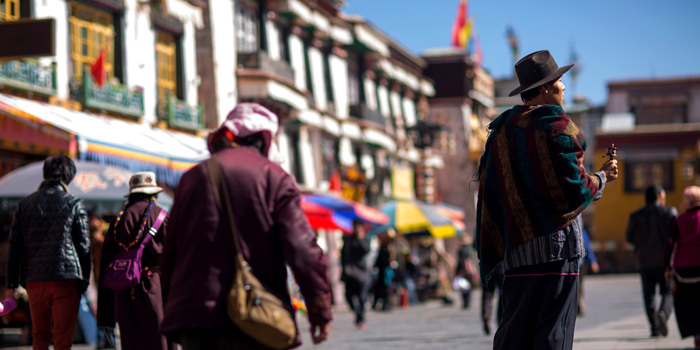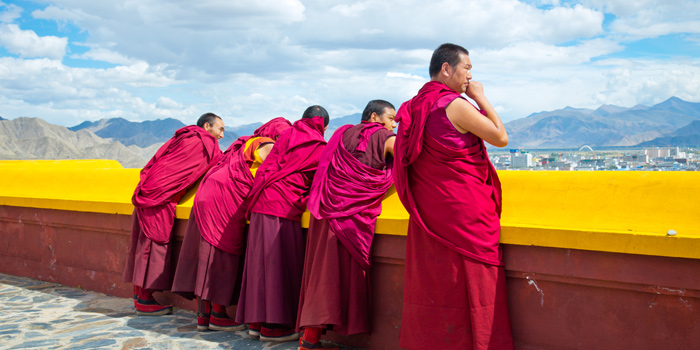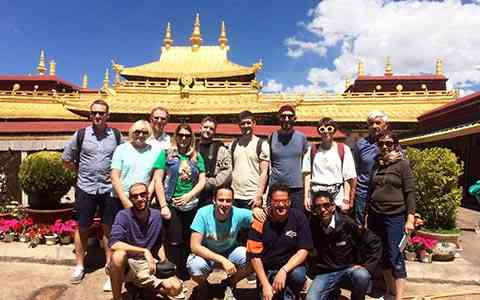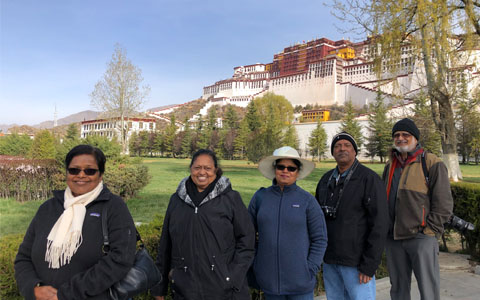What is Kora in Tibet? The Most Popular Kora You Can Join in during a Tibet Trip
In Tibet, pilgrims embark on journeys to the holiest sites, walking a prescribed route known as "kora" in a prayerful ceremony to the Bodhisattvas of Tibetan Buddhism. This tradition is an integral part of Tibetan Buddhist life, believed to bring spiritual merits and protection from misfortune.
For first-time visitors to Tibet, witnessing the devout walk around temples, spinning prayer wheels, and chanting may appear unusual, but it is a deeply ingrained aspect of both Tibetan culture and the Buddhist religion. Almost every Tibetan Buddhist has taken part in this sacred practice at least once in the region.
In this article, we are going to introduce the captivating world of "kora" and shed light on its profound significance in Tibetan life. Let's delve deeper into this sacred journey of devotion and enlightenment.
 What is a Kora Like in Tibet? How Tibetan People Do the Kora in their Daily Life?
What is a Kora Like in Tibet? How Tibetan People Do the Kora in their Daily Life?
 No.1 Kora Route of Tibet: Kora around the Jokhang Temple of Lhasa (Nangkhor Kora)
No.1 Kora Route of Tibet: Kora around the Jokhang Temple of Lhasa (Nangkhor Kora)
 No.2 Kora Route of Tibet: Kora around the Barkhor Street of Lhasa; 2km, about 30 Mins (Barkhor Kora)
No.2 Kora Route of Tibet: Kora around the Barkhor Street of Lhasa; 2km, about 30 Mins (Barkhor Kora)
 No.3 Kora Route of Tibet: Kora around the Potala Palace of Lhasa; 3km, 45 Mins (Tsekhor Kora)
No.3 Kora Route of Tibet: Kora around the Potala Palace of Lhasa; 3km, 45 Mins (Tsekhor Kora)
 No.4 Kora Route of Tibet: Kora around the Old Town of Lhasa; 8km, 2-3 hours (Lingkhor Kora)
No.4 Kora Route of Tibet: Kora around the Old Town of Lhasa; 8km, 2-3 hours (Lingkhor Kora)
 No.6 Kora Route of Tibet: Kora around the Namtso Lake; 70 km, about 20-30 days
No.6 Kora Route of Tibet: Kora around the Namtso Lake; 70 km, about 20-30 days
What is a Kora Like in Tibet? How Tibetan People Do the Kora in their Daily Life?
Kora in Tibet is a sacred practice where pilgrims walk around a holy site in a clockwise direction. It is an integral part of Tibetan Buddhism, believed to lead to enlightenment and purify negative karma.
This tradition dates back to the time of the original Buddha and is widely practiced in Tibet around various sacred objects and places.
Kora is not just a spiritual ritual but an essential aspect of daily life for Tibetans, blending religious and cultural significance.
The locations and actions during Kora hold great spiritual significance, and it involves practices like reciting mantras, prostrations, and deep devotion.
During a visit to Lhasa, it's common to observe many local Tibetans engaging in Kora around revered places like the Potala Palace or the Jokhang Temple along the Barkhor Street. For them, this practice is an integral part of their daily routine, reflecting the deep religious and cultural significance of Kora in their lives.
No.1 Kora Route of Tibet: Kora around the Jokhang Temple of Lhasa (Nangkhor Kora)
This kora is considered to be the supreme kora, and the one closest to the Sakyamuni Buddha, following a route inside the world famous Jokhang Temple.
Jokhang Temple is known as the spiritual heart of Tibet, as it is the site of the statue of the 12-year-old Sakyamuni Buddha, which was brought to Tibet by the Princess Wencheng, in 640 AD. This kora follows a route that goes around the hall that still houses the statue of Sakyamuni Buddha.
Due to its closeness to the statue, it is believed to be the holiest of koras, and there is a daily flow of Tibetan Buddhists that follow this path, spinning the 380 prayer wheels that line the route, before worshipping the Buddha inside the hall.
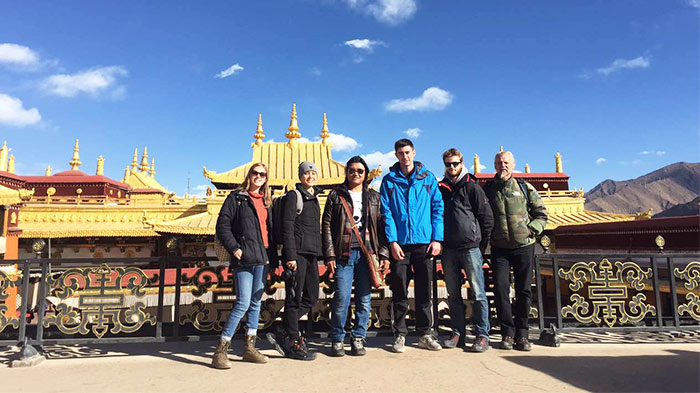 Jokhang Temple is the spiritual heart of Tibet, where local pilgrims perform the kora throughout their lifetime.
Jokhang Temple is the spiritual heart of Tibet, where local pilgrims perform the kora throughout their lifetime.
No.2 Kora Route of Tibet: Kora around the Barkhor Street of Lhasa; 2km, about 30 Mins (Barkhor Kora)
Running along what is possibly the busiest street in Lhasa, Barkhor Kora is the most historical kora in Tibet. The ancient circuit follows a path around the exterior of the Jokhang Temple, along Barkhor Street, which now runs all the way around the temple.
Barkhor Street, a popular place for visiting foreign tourists, gets its name from the fact that it is “between” the Nangkhor Kora and the old city of Lhasa. The kora is 2 kilometers long, and starts at the main entrance to the temple. The circuit takes about 30 minutes, and follows Barkhor Street all the way around the temple, with the smoke of burning juniper filling the air, and crowds of tourists and Tibetans following the route.
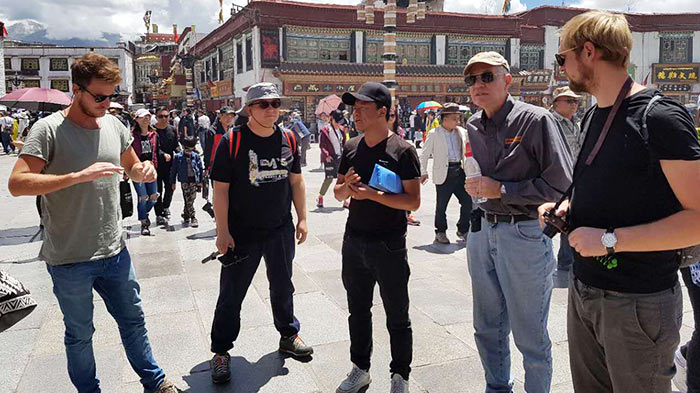 Our local guide explains the meaning of Kora in Barkhor Street.
Our local guide explains the meaning of Kora in Barkhor Street.
No.3 Kora Route of Tibet: Kora around the Potala Palace of Lhasa; 3km, 45 Mins (Tsekhor Kora)
The Potala Palace, a celebrated center of Tibetan Buddhist pilgrimage, also has its own Kora. The route follows a path around the base of Moburi, the hill on which the majestic palace stands. Referred to as "Tsek Potala" by Tibetans, the Tsekhor Kora is the "circumambulation of Potala."
Having a long and diverse history in Tibet, the Potala Palace is one of the oldest sites of Tibetan Buddhism. This beautiful palace, with its striking red and white architecture, holds a special place in the hearts of Tibetans. The 3km Kora route takes around 45 minutes to complete and is highly popular among pilgrims who travel to Lhasa for prayer and devotion.
No.4 Kora Route of Tibet: Kora around the Old Town of Lhasa; 8km, 2-3 hours (Lingkhor Kora)
Lingkhor Kora traces the outer boundary of the old city district of Lhasa, and at 8 km, is the longest kora route in Lhasa. The pilgrims take 2-3 hours to complete one circle to finish the circuit. While circling around Lingkhor Kora, the Tibetan pilgrims spin the hand wheel and chant Buddhist scriptures. This Kora route and the journey give the pilgrims an essential sense of solace and peace.
 Tibet lhasa Potala Palace Lingkhor Kora
Tibet lhasa Potala Palace Lingkhor Kora
No.5 Kora Route of Tibet: Kora around the Ganden Monastery, Sera Monastery, Drepung Monastery or the Tashilhunpo Monastery; Each for at Most 2 hours
Ganden Monastery, Sera Monastery, Drepung Monastery, and Tashilhunpo Monastery hold deep religious significance and are revered centers of Tibetan Bhuddhism. These monasteries are often situaded amidst picturesque scenery, offering stunning vistas of the Tibetan plateau and its unique architecture.
 Kora in Ganden Monastery
Kora in Ganden Monastery
Each of these kora routes can be completed in approximately 2 hours, making them perfect one-day treks around significant spiritual locations. During the kora, you will immerse yourself in the spiritual embiance and exprience the profound sense of devotion that permeates these sacred sites.
No.6 Kora Route of Tibet: Kora around the Namtso Lake; 70 km, about 20-30 days
Lake Namtso kora around one of the three holy lakes of Tibet is a very significant pilgrimage for Tibetan Buddhists. Namtso means “heavenly lake” in Tibetan, and it is just that. The lake is 70km long and 30km wide, and the average pilgrimage around the lake normally takes around 20-30 days.
 Kora in Namtso Lake
Kora in Namtso Lake
No.7 Kora Route of Tibet: Kora around the Mount Kailash: 52km, 3 Days - the Most Popular Kora Route for Our Clients
Circumambulating the most holy mountain in the words, Mount Kailash kora is one of the most popular of all the koras in Tibet, and the most popular for our clients. The route starts at the village of Darchen, and winds along the base of the Kailash Massif, over one of the highest passes in the region, and down through a lush, sloping valley to the end. The route covers 52km and takes three days on foot or horseback, and stops are made overnight at the monasteries around the route.
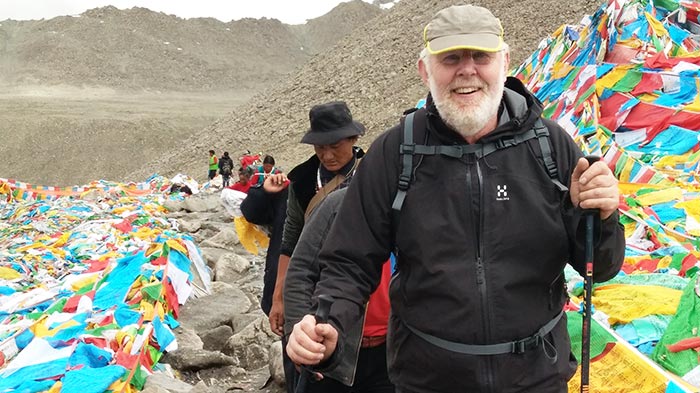 Circumambulating Mount Kailash
Circumambulating Mount Kailash
No.8 Kora Route of Tibet: Kora around the Lake Manasarovar: 30km, 5 days; Tourist Bus is Available - about 3 hrs Driving
Lake Manasarovar, as one of the three great sacred lakes in Tibet, offers a beautiful kora route that passes through stunning scenery. Starting and ending at Chiu Monastery, set atop a hill that overlooks the northwest of the lake, pilgrims can see the five Buddhist monasteries around Lake Manasarovar along their journey. Covering 30km, the Manasarovar kora is a five day trek on foot. A tourist bus is also available that can complete the trip in 3 hours.
Conclusion
Completing one of the traditional kora routes is a great way for you to experience an important part of local culture during your Tibet tour. Each of the top kora routes has something unique to offer. From stunning natural landscapes to sites of historical and spiritual significance, there are choices to fit into any travel schedule or area of interest.
No matter the choice, every kora brings with it the opportunity to join with local pilgrims in a spiritual practice that Tibet Buddhists believe an important part of moving a person along the path to enlightenment.

The Lhasa-born prodigy used to study business overseas, and got his Bachelor of Business in Nepal and India before moving back to his homeland. With pure passion for life and unlimited love for Tibet, Kunga started his guide career as early as 1997.
Responsible, considerate, and humorous, he devoted his entire life to guiding and serving international tourists traveling in Tibet. As a legendary Tibetan travel guru with 20-year pro guide experience. Currently, he is working in Tibet Vista as the Tour Operating Director. Whenever our clients run into trouble, he is your first call and will offer prompt support.
Related Articles & Posts
Most Popular Tibet Tour Packages
-

Lhasa - Gyantse - Shigatse - Everest Base Camp - Shigatse - Lhasa
USD939
View Details -

Lhasa - Gyantse - Shigatse - E.B.C - Saga - Kailash Trek - Darchen - Lake Manasarovar - Saga - Gyirong - Tingri - Lhasa
USD2059
View Details -

10 Days Lhasa to Everest Base Camp and Namtso Lake Small Group Tour
Lhasa - Gyantse - Shigatse - EBC - Shigatse - Lhasa - Namtso Lake - Damxung - Lhasa
USD1289
View Details -

8 Days Driving Across Himalaya Overland Adventure from Kathmandu to Lhasa
Kathmandu - Gyirong - Everest Base Camp - Tingri - Shigatse - Gyantse - Lhasa
USD1069
View Details -

4 Days Lhasa Impression Small Group Tour: Explore the Heart of Tibet and Mingle with the Locals
Lhasa
USD509
View Details -

Lhasa - Gyantse - Shigatse - Everest Base Camp - Gyirong - Kathmandu
USD979
View Details -

Lhasa - Gyantse - Shigatse- Lhasa
USD799
View Details -

13 Day Lhasa, Mt. Everest, Mt. Kailash, Lake Manasarovar and Kathmandu Adventure Tour
Lhasa - Gyantse - Shigatse - EBC - Saga - Darchen - Kailash Trek - Darchen - Saga - Gyirong - Kathmandu
USD2059
View Details


.jpg)



